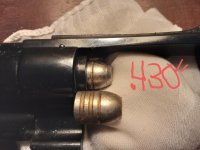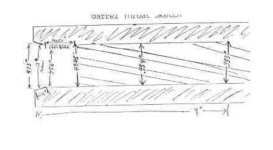44 Magnum. Forcing cone diameter- SAAMI doesnt seem to have a specification on it. Online a guy said groove diameter X 1.05" = diameter.
My S&W 44 mag would have a forcing cone mouth diameter of .450" using this math.
The photo shows .451" diameter bullet in the barrel. Not even close to a tight fit.
The flat base bullet has stopped in the barrel where it measures .451" Seems like a lot of slop?
The factory set the barrel back last year. & cleaned up the forcing cone.
Does anyone have specifications of what it should measure?
Thank you.
My S&W 44 mag would have a forcing cone mouth diameter of .450" using this math.
The photo shows .451" diameter bullet in the barrel. Not even close to a tight fit.
The flat base bullet has stopped in the barrel where it measures .451" Seems like a lot of slop?
The factory set the barrel back last year. & cleaned up the forcing cone.
Does anyone have specifications of what it should measure?
Thank you.









